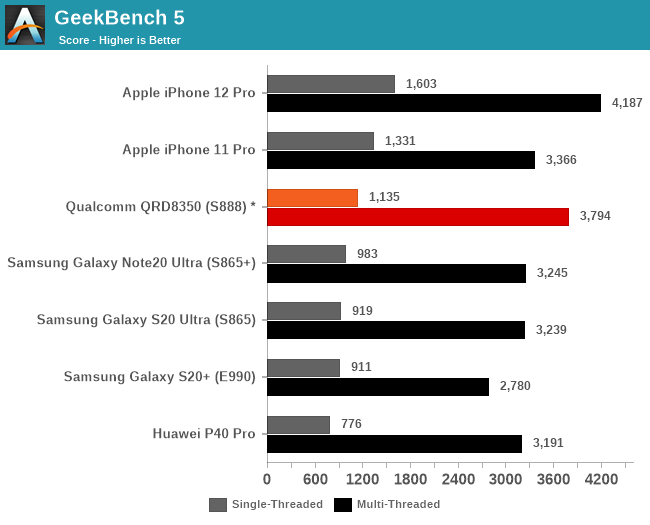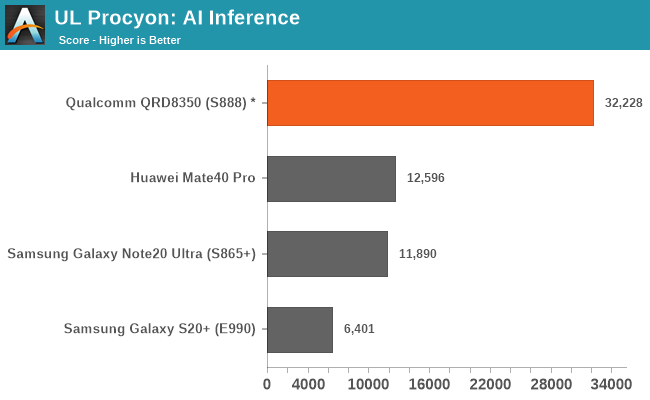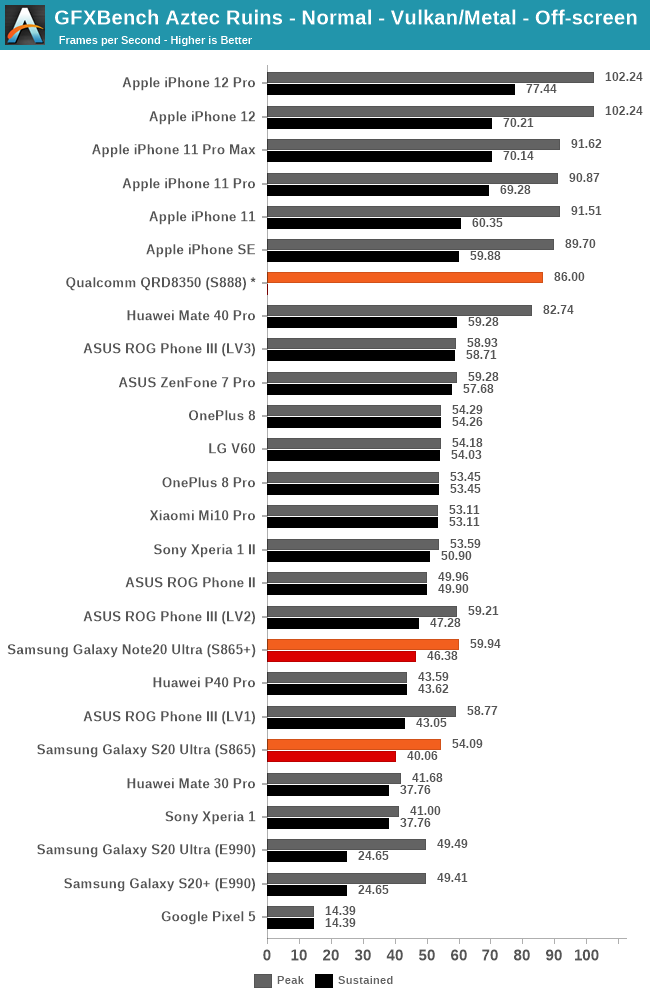Qualcomm Discloses Snapdragon 888 Benchmarks: Promising Performance
by Andrei Frumusanu on December 18, 2020 9:30 AM EST- Posted in
- Mobile
- Qualcomm
- Smartphones
- Cortex X1
- Snapdragon 888

Today Qualcomm is disclosing a set of benchmark results for their new Snapdragon 888 SoC that’s set to power next year’s flagship Android devices. Usually, as in years past, we would have had opportunities to benchmark Qualcomm’s reference designs ourselves during the chipset launch event, or a few weeks later during CES. However due to obvious circumstances, this wasn’t possible this year.
As an alternative, Qualcomm is instead sharing with the press a set of benchmark results from their new Snapdragon 888 reference design phone. Usually, the point of having the press benchmark the devices themselves is that it adds independent verification of the benchmark scores. This time around we’ll have to make a little leap of faith in the accuracy of Qualcomm’s numbers – of course we still pretty much expect the figures to be accurate and be reproduced in commercial devices.
Unfortunately, because the majority of our more interesting mobile test suite around SoCs is comprised of custom internal benchmarks, that means that those will be missing from today’s rather brief coverage.
Among the benchmarks that Qualcomm has run are AnTuTu, GeekBench, GFXBench Aztec Normal and Manhattan 3.0, Ludashi AiMark, AITuTu, MLPerf and UL Procyon. We really only run a subset of those benchmarks are part of our regular coverage, so I’ll just be focusing on the very basics with GeekBench, GFXBench and Procyon.

Starting off we have GeekBench 5, which in my opinion is generally a good overall performance benchmark for CPUs, and generally scales in line with SPEC. Here we see the new Snapdragon 888’s first-time use of Cortex-X1 cores in action.
The single-threaded performance score has gone up from 919 points on the Snapdragon 865 to 1135 on the new SoC, a 23.5% performance uplift versus its direct predecessor. This is relatively in line with Qualcomm’s promoted performance boost of 25%, and generally is what we expected given Qualcomm’s implementation of the Cortex-X1 in the new chipset. As a reminder, the new X1 cores are clocked at 2.84GHz – the same frequency as the A77 cores on the S865, but lower than the 3.09GHz A77 cores of the Snapdragon 865+. As a result, against the 865+ the 888's performance advantage is only 15.4%, which doesn’t sound quite as exciting.
Multi-threaded performance of the new chip comes in at 16.9% better than its predecessors. This actually was a bit odder to see as I was expecting larger improvements. Thinking more about it, I guess it makes sense – the new Cortex-A78 core, which is being used as the 3x middle cores of the new SoC, is only advertised as offering a 7% IPC advantage over its predecessor.
Meanwhile, Qualcomm did increase their L2 cache size on the middle cores from 256KB to 512KB, but otherwise left their clock frequencies unchanged at 2.42GHz. Together with the unchanged 4x Cortex-A55 cores at 1.8GHz I guess the overall performance for the complete cluster hasn't really changed all that much, with the X1 prime core being the hero of the show for this generation.
Moving on to GPU performance, the new Snapdragon 888 features the new Adreno 660 GPU, where Qualcomm promises a 35% performance uplift. Qualcomm published GFXBench Aztec Normal and Manhattan 3.0 scores. We moved on from Manhattan 3.0 to Manhattan 3.1 long time ago, so we don’t have comparison scores against Qualcomm’s 169fps figure, but we do run Aztec Normal.
In this benchmark, Qualcomm’s listed score of 86fps is over 55% faster than previous generation Snapdragon 865 devices. This might be an outlier score, or it could be sign of the benefits of the additional memory bandwidth afforded by the SoC's faster LPDDR5-6400 support – Qualcomm did say that this generation the GPU will be able to stress that part of the chip much harder.
While the Snapdragon 888 doesn’t look like it’ll match the peak performance scores of the A13 or A14 SoCs used in Apple's iPhones, sustained performance will depend quite a bit on the power consumption of the chip. If this lands in at between 4 and 4.5W, then the majority of flagship Android phones in 2021 will likely be able to sustain this peak performance figure and allow Qualcomm to regain the mobile performance crown from Apple. Otherwise if the chip has to significantly throttle, then 888 will probably fall short of retaking the crown. But even if that's the case, for Android users it shouldn't matter too much: the generational leap over 2020 phones would still be immense, and by far one of the largest GPU performance leaps Qualcomm has been able to achieve to date.

In terms of AI Benchmarks, Qualcomm didn’t really present anything in the same manner that we do, so this is a good opportunity to add UL’s new Procyon AI Inference benchmark to our suite.
The benchmark is able to run on various accelerators blocks within an SoC, and it's also is able to take advantage of custom TensorFlow Delegates, such as Samsung’s EDEN framework.
Here the new Snapdragon 888 is posting outstandingly good performance, delivering almost 3x the score of the Snapdragon 865+ and outright exceeding the theoretical throughput rate increases of the new Hexagon 780. The new Hexagon is a completely new IP and pretty much the single biggest improvement of the whole Snapdragon 888 as it promises great advancements in performance and power efficiency – not only against previous generation Snapdragons but also against competitor designs which don’t yet have such a flexible DSP/ML hardware block in their SoCs.





Qualcomm surprisingly also published MLPerf results on the new chip. The Android version of MLCommons' benchmark suite is fresh out the oven, and among other things, gives us a new standardized test that’s more aligned across the industry.
The new Snapdragon 888 is showcasing tremendous performance leaps compared to its predecessor, with gains of up to 4x in some of the tests. Again, this is well beyond just the theoretical computational throughput improvements of the execution units of the IP blocks, and very likely is tied to the new memory architecture of the new Hexagon block as a whole.
Overall Good First Impressions – Waiting For First Devices
Following up on its announcement just a few weeks ago, today’s benchmark score release helps to further validate our first impressions of (and expectations for) Qualcomm's new Snapdragon 888 SoC.
On the CPU side we’re seeing good improvements, even with Qualcomm's conservative claims. And meanwhile the new Adreno GPU seems to perform as well as Qualcomm has promised – if not a bit better. So as things stand, the missing piece of the puzzle is power consumption; if it ends up being competitive there, then Qualcomm has a shot at regaining the performance crown in mobile.
Finally, the new Hexagon DSP really stood out as being the most exciting piece of new hardware in the Snapdragon 888. These performance figures underscore just how far Qualcomm has come in a single generation, as evidenced by the new SoC's tremendous performance leaps over earlier chips.
Ultimately, while this isn't really one of our traditional performance previews – seeing as how we have to place trust in Qualcomm that their figures will be reproducible on commercial devices – it's at least a starting point for talking about performance. And, with that taken at face value, it’s looking like the new Snapdragon 888 won’t disappoint, setting up Qualcomm for another solid year of execution on the SoC front.
Related Reading:
- Qualcomm Details The Snapdragon 888: 3rd Gen 5G & Cortex-X1 on 5nm
- Qualcomm Tech Summit 2020: Day One LiveBlog (10:00 ET, 15:00 UTC)
- Qualcomm’s New 3rd Generation Snapdragon X60 5G Modem, Built on 5nm
- Qualcomm Announces Snapdragon 865+: Breaking the 3GHz Threshold
- The Snapdragon 865 Performance Preview: Setting the Stage for Flagship Android 2020
- Qualcomm Announces Snapdragon 865 and 765(G): 5G For All in 2020, All The Details
- The Snapdragon 855 Performance Preview: Setting the Stage for Flagship Android 2019
- The Qualcomm Snapdragon 855 Pre-Dive: Going Into Detail on 2019's Flagship Android SoC











75 Comments
View All Comments
iphonebestgamephone - Friday, December 25, 2020 - link
And where are those numbers from?darkich - Saturday, December 26, 2020 - link
Straight from Applehttps://www.apple.com/hr/newsroom/2020/11/apple-un...
darkich - Saturday, December 26, 2020 - link
p.s. I'll admit the number for the CPU is a guesstimate on my part, but pretty objective. AFAIK, even the highest end desktop 32 core AMD Zen 2 doesn't cross 1TFLOPS.Regardless, doesn't make a difference to my point.
Qualcomm's smartphone chip crushed the M1 in AI department
iphonebestgamephone - Saturday, December 26, 2020 - link
And how did you convert those tflops into tops?darkich - Sunday, December 27, 2020 - link
I didn't. You suggested that we include TFLOPS along with TOPS in your first reply..right?Anyway, TOPS are the general measure and TFLOPS are more specific.
iphonebestgamephone - Sunday, December 27, 2020 - link
Since tflops are more specific, wouldnt that mean its able to do more tops than tflops? And from apples page 'with a powerful 8‑core GPU, machine learning accelerators and the Neural Engine, the entire M1 chip is designed to excel at machine learning.'darkich - Sunday, December 27, 2020 - link
Uh..I was hoping the logic would come to you.T0PS means trillion operations per seconds.. so, a general measure. TFLOPS means trillion floating operations per second, so more specific part of the general measure.
iphonebestgamephone - Sunday, December 27, 2020 - link
What logic? I know what the full form is. Shouldnt the entire soc be able to do a higher number of general tasks (tops) than specific ones (tflops)?iphonebestgamephone - Sunday, December 27, 2020 - link
Wouldnt the specific task be just a part of the general tasks?darkich - Monday, December 28, 2020 - link
That's exactly what I am saying..so where is this going then?TFLOPS are still TOPS.
For Snapdragon 888, if we count the TOPS for entirety of the soc, then the GPU part should be around 1.6TOPS( because Adreno 660 ~ 1.6 TFLOPS), and the CPU is much less than a 1 TFLOPS.
That means the AI engine alone should be able to do at least 24 TOPS.
Bottom line - well over 2x that of the M1.
Get over it.